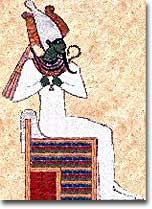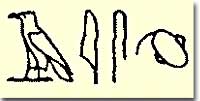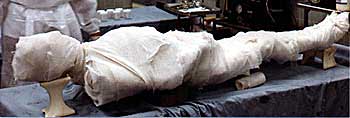3d. Mummies


A dead noble stands trembling in the Hall of Truth. Behind the noble, Horus, the half-falcon, half-man ruler of Earth, unleashes a piercing stare at the quivering man. Thoth, the sharp-beaked, ibis-headed deity of scribes, sharpens his quill — poised to record a verdict of divine judgment.
Seated before the noble on a golden throne is Osiris, the king of the dead. Upon his head rests a glittering crown with a gorgeous white feather plume on either side. Behind Osiris stands Isis, the revered goddess of nature, who is responsible for bringing the dead earth back to life each year. She holds an ankh, a cross with a loop above the bar. An ankh guarantees that a dead person will live forever.
The noble wonders if he will live forever. Or will he be fed to the hideous crocodilelike god called the Eater of the Dead and forever cease to exist. (How can the noble wonder about all this if he's already dead? The noble is actually in limbo, a place where the souls of dead people go while being judged.)
Osiris begins the process of judging the noble's life. On one side of a scale, Osiris places the heart of the noble, which bares the secrets of the soul. Had the soul lied, cheated, or lived an evil life? The soul defends itself before a variety of interrogating gods.

Thought to be the oldest surviving medical text (1600 B.C.E.), the Edwin Smith Papyrus explains the treatment of wounds in Egyptian medicine. What important organ does this hieroglyphic spell out?
The noble thinks about his second self, called the ka. The ka lives within every human being. When the physical body expires, the ka goes on to enjoy eternal life, where it can hunt, fish, live with its family, be entertained, and eat favorite foods.
Now Osiris holds up the sacred feather, the emblem of truth, and places it on the other side of the scale. If the scales balance, eternal life awaits. If not, the Eater of the Dead has his favorite food for lunch: noble.
|
My heart, my mother! My heart whereby I came into being! May nought stand up to oppose me at [my] judgment, may there be no opposition to me in the presence of the Chiefs; may there be no parting of thee from me in the presence of him that keepeth the Balance! Thou art my ka, which dwelleth in my body; the god Khnemu who knitteth together and strengtheneth my limbs. Mayest thou come forth into the place of happiness whither we go. May the Sheniu officials, who make the conditions of the lives of men, not cause my name to stink, and may no lies be spoken against me in the presence of the God. -"Prayer of Ani," from the Book of the Dead (c. 1,700 B.C.E.) | ||
The Egyptian Pantheon
Alternate names are in (parentheses). Some of the duties and animals of the Egyptian gods overlapped. The gods listed below were most popular during the Age of the Pyramids.
| Name of god or goddess | Symbol | Role or Purpose |
| Amun | "the hidden one" | god of the atmosphere, sun, sky, and empire |
| Anti (Anty) | hawk, falcon | guardian of the living |
| Anubis | jackal, dog | guardian of the dead, mummification |
| Atum | "the complete one," setting sun | creator of the universe |
| Babi | baboon | demon god of the underworld |
| Bastet | cat | goddess of the home |
| Bat (Bata) | buffalo, cow | ancient goddess of kingship, became Hathor |
| Geb (Keb, Seb) | goose | god of the Earth |
| Hapi (Hapy) | large bearded human with a crown of plants | god of the Nile flood, abundance, fertility |
| Hathor | cow | goddess of love, music, song, and dance |
| Heket (Heqet) | frog | goddess of childbirth, fertility |
| Heh | kneeling man holding two palm ribs | god of eternity, longevity |
| Horus (Har, Hor) | falcon | warrior-king of the gods |
| Isis (Aset, Eset) | Sirius, the brightest star in the sky | goddess of resurrection, announcer of the flood |
| Khnum (Khnemu) | ram | creator of the Nile flood, builder of the Great Pyramid |
| Maat (Ma'at, Mayet) | female wearing an ostrich feather | goddess of truth, justice, order, and balance |
| Min (Minu, Menu) | white bull | god of fertility, protector of the eastern mines |
| Neith (Neit) | two crossed arrows behind a shield | goddess of northern Egypt, hunting, warfare |
| Nekhbet (Nekhebet, Nechbet) | vulture | goddess of Upper Egypt, protector of the king |
| Nephthys | royal palace, kite | goddess of the dead |
| Nut (Neuth, Nuit) | sky | mother-goddess |
| Osiris (Usire) | man wrapped in the linens of mummification | god of the dead, underworld, agriculture |
| Ptah | bull | ancient creator-god of Memphis, patron of craftsmen and artisans |
| Re (Ra) | sun | king of the gods |
| Renenutet (Ernutet, Renenet) | cobra | mother-goddess, witness at births |
| Sakhmet (Sachmet) | "the powerful one," lioness | goddess of war, protector of the people |
| Seth (Set, Setekh, Setesh, Seti, Sutekh, Setech, Sutech) | oryx, boar, crocodile, hippopotamus | god of the desert, chaos, and storm |
| Shu (Su) | male wearing an ostrich feather | god of air and light |
| Sobek (Sebek, Sebeq, Sebk, Sabk) | crocodile | god of kingship, decisive action, and violence |
| Sokar (Seker) | hawk | patron of the Memphis royal cemetery |
| Tefnut (Tefnet, Tefenet) | lioness | goddess of moisture, dew, rain, and mist |
| Thoth (Thot, Thout, Tehuti, Djhowtey, Djehuti, Zehuti) | ibis, baboon | god of scribes, writing, justice, truth, wisdom, knowledge, and the moon |
| Wadjet (Uto) | snake | one of the king's protector goddesses |
Mummification
Before being judged by Osiris, the noble's soul had undertaken a journey that lasted over two months. When the noble died he was brought to the Beautiful House, where an embalmer (often a priest with knowledge of rituals, wrapping, and anatomy) prepared the body to cross to the afterlife.
Egyptians believed that the afterlife would be much like life on Earth and that the soul would want use of its body in eternity. That's why Egyptians made an art out of mummification, or the preservation of the dead.
The process of embalming took great skill and required many steps. What follows is a crash course on Egyptian embalming technique.

This is an example of an Egyptian coffin made of wood, painted, then gilded. Created during the Ptolemaic Period (305-30 B.C.E.), the lid is adorned with images from the Book of the Dead, a text believed to lead the dead into the lands of Osiris, the god of the underworld.
- Removal of the Brain
With long hooks, the brain is extracted through the nasal passage. The Egyptians didn't think that the brain had any special use. - Organ Removal (Evisceration)
A cut is made on the left side of the body, and the liver, lungs, and other organs are removed, dried out, and stored in sacred vessels called canopic jars. The heart is left in the body, because it will be needed to be weighed in judgment by Osiris. - Dehydration with Natron Crystals
Now the body must be dehydrated (have the liquids removed) to stop decay. A type of salt called natron is used. Natron crystals are packed around the body. The crystals absorb body fat and fluids and keep the body from decaying. After being treated for about 40 days, the corpse is washed and dried. - Stuffing
Because the body has lost much of its mass, resin-stained clothes or bits of sawdust are used to pack the corpse, which by now has also lost its eyeballs. Pieces of cloth are stuffed in the eye sockets and painted black. At this point, the corpse's lips and cheeks are painted. - Oiling the Body
This elaborate process includes, massaging, perfuming, and anointing (blessing with oil) the corpse. - Coloring
After the nose and mouth are filled with cloth scraps to restore the shape of the face, the body is colored. Men are colored red; women are colored yellow. After the coloring, resin is poured into body cavities. - Arrangement of the Body
Depending on which period of Egyptian history the deceased lived in, the arms are either placed to the side of the corpse, folded on its chest, or placed with hands on shoulders. - Wrapping
The body is wrapped in several layers of fine linen; and various body parts receive particular attention. This process takes two weeks, after which a resin is added to the bandages. - Funerary Mask
A mask, sometimes made entirely of gold, is fitted to the mummy's body. Symbols of gods often adorned masks. - Burial of Waste
All materials used to prepare the corpse (such as natron and bloody linen) are placed in a jar and buried away from the mummy's tomb.

Finally, the time has come to entomb the mummy. Jewelry, games, furniture, food, clothing, and cosmetics might be entombed with the corpse. These things would be used in the afterlife. The Book of the Dead, a collection of hymns and prayers, might also be included in the tomb to protect the body on its journey to the realm of the dead.
So how did the noble fare before the great Osiris? Ask his mummy.








